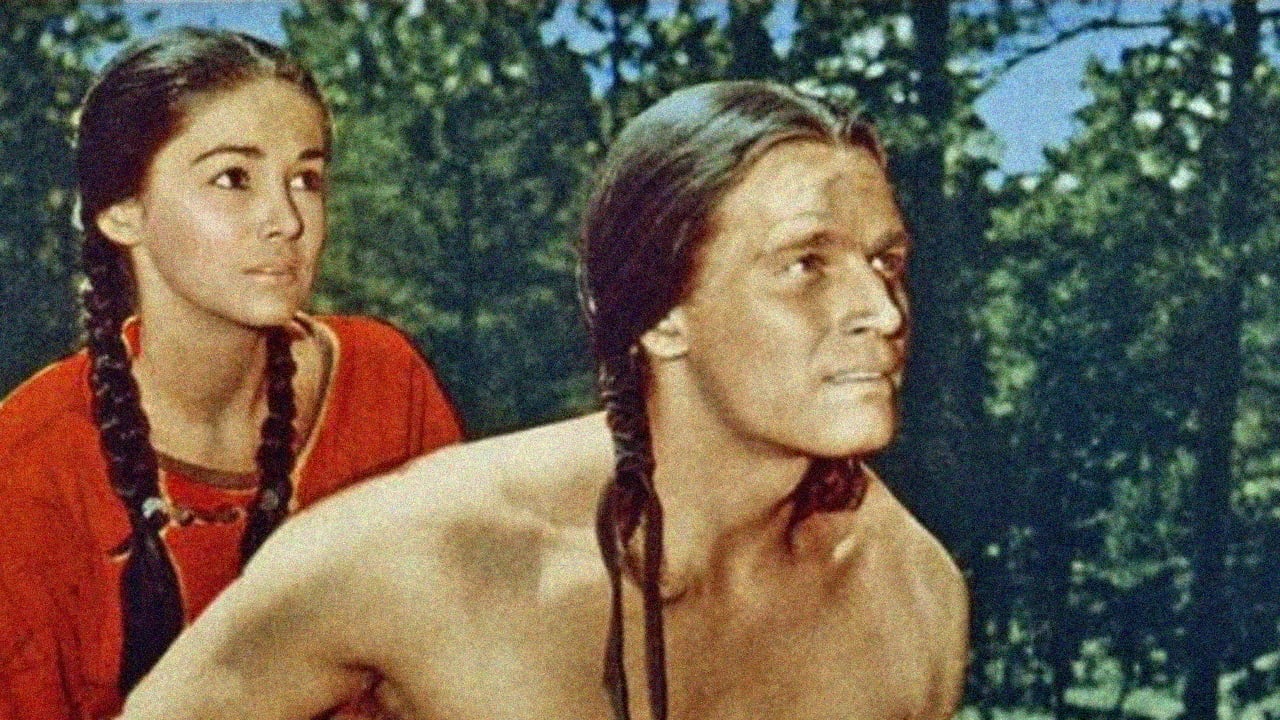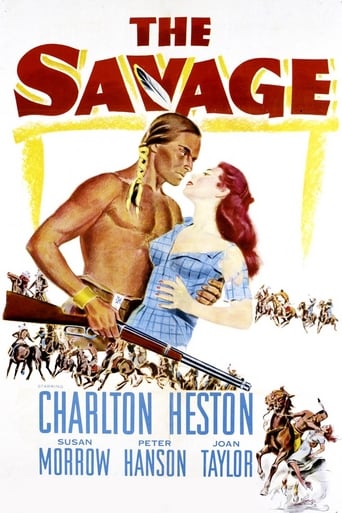



Just perfect...
Your blood may run cold, but you now find yourself pinioned to the story.
View MoreEasily the biggest piece of Right wing non sense propaganda I ever saw.
View MoreStory: It's very simple but honestly that is fine.
This is a very unusual sort of western and in some ways I commend it. On one hand, the film is very sensitive in its portrayal of the American Indians--much more so than the typical film of the day. They are NOT savages (despite the title) and have much to admire. Yet, on the other hand, most of the 'Indians' are actually just white actors in brown paint--an opportunity lost for real Indian actors.The film begins with a wagon train being attacked by the Crow tribe. All but one are killed--a young boy survives and is adopted by the Sioux. This boy grows into Charlton Heston--and it made sense to have a white actor playing this role. He is caught in the middle--as the Sioux are moving towards being pushed to fight against the white men to survive. But some of the Sioux are worried he has divided loyalties and favors the whites over his own people. So, Heston has to show his loyalty while at the same time taking a cautious approach--as he and his adopted father do not want a war if it can be avoided (which, as history has demonstrated, was not possible). And, if war comes, on which side will he fight?! In many ways, this film is reminiscent of later westerns like "Little Big Man" and "Dances With Wolves" because these films, too, are told from the natives' point of view. And, they all have a white guy in the lead who has been adopted by the tribe. If you think about it, this is a HUGE step from the typical westerns of the era where the Indians are all faceless savages and idiots. Yet, they also are a bit paternalistic because they MUST have a white guy in the lead. Wouldn't it be interesting if the leading man was an American Indian?! Overall, a better than average western that isn't perfect but it does have a unusual take on the typical cowboys versus Indians plot.
View MoreTo a large degree calling this film The Savage is quite the misnomer because Charlton Heston as the lead character is anything, but savage. Heston who starts out in the film with his character as a child played by Orley Lindgren is the only survivor of a wagon train massacre by the Crow Indians. A band of Sioux drive off the Crow who are their bitter enemies and take in Heston who is raised by the Sioux and given the Indian name War Bonnet.That's his last real contact with white people until years later he rescues some cavalry troopers pinned down by the Crows who are his mortal enemies now as well. Lieutenant Peter Hansen brings him to the cavalry fort where he's accepted and even evinces some interest by Hansen's sister Susan Morrow. But when Heston's own Indian sister Joan Taylor is killed by some other troopers the Sioux call for war and Heston is in the fight.The Savage is a sincerely made effort at showing the American Indians as three dimensional characters in line with Broken Arrow and Devil's Doorway which came out a couple of years earlier. But the script and plot are totally muddled and with it Heston's character. In the end I'm not sure how or why he was doing what he did.Heston does well in the part and another crucial role of note is that of Indian hating army captain Richard Rober whose career was cut short when he was killed in an automobile accident. He played a fine selection of villains in his short career and his last film was released five years after he died. Rober probably hid his face in shame in an afterlife when Jet Pilot came out.In Heston's early years between those two DeMille epics The Greatest Show On Earth and The Ten Commandments his films varied in quality from good to mediocre. The Savage kind of falls between both categories, good intentions with poor execution.
View MoreComing two years after "broken arrow",this movie continues in the same vein:the Indians are treated as human beings who have wisdom and whose struggle is legitimate.Most of them are loyal,even if there are traitors and cowards among them(the same goes for the white ones).Actually,it's John Ford who came first as an Indians' champion with "fort Apache"(1948)."The savage" is a moderately satisfying western,which owes a lot to Charlton Heston's majestic presence.The pastoral scenes are nice enough but they don't cut these of "Broken arrow".For instance, the female character has not Debra Paget's radiant presence and anyway she disappears too soon.The direction has neither Daves' lyricism,nor Ford's or Mann's epic inspiration,even less Walsh's madness.Sometimes Georges Marshall (and his scriptwriters) look like school teachers,giving good and bad marks, sometimes to the Indians,sometimes to the "soldier blue".The topic of the man torn between two cultures will be resumed by Martin Ritt in the sixties (Hombre,1967)and Kevin Costner's "Dance with wolves" will be a successful update of "broken arrow".As for Marshall's film,Charlton Heston's numerous fans may appreciate his convincing rendition.
View MorePhotographed in color in the Black Hills of South Dakota, George Marshall's "The Savage" is a sympathetic look at the Indian Sioux presenting them as people, recurring on love and loyalty based on mutual respectin this case, the bond between a Chief Indian and his adopted son...The film opens in 1868 on Sioux country, with a wagon trail attacked by the aggressive Crow Indians... All are massacred except Young Heston, eleven-years old... Sioux warriors arrive on the scene, in their eyes the young boy is a brave warrior, instantly adopted by Yellow Eaglechief of this Miniconju branch of the Sioux with the name of War Bonnet...Time goes by and the boy grows to manhood... War was about to break out between the Sioux nation and the white men... Heston has to decide soon on whose side will fight... Meanwhile, a pretty young squaw named Luta (Joan Taylor) has fallen in love with Heston who sees her only as his "little" sister... She reacts by calling him: "Man of stone, man who sees no woman, man of no love. Blind one!"The great moment of the film is the test of truth, before the assembled warriors in the great council meeting, questioning on Heston's divided loyalty... Yellow Eagle's only request: "My son. I ask only one thing. Do not bring disgrace to my name."Charlton Heston early efforts as an actor are exciting:Heston, the best warrior: galloping at full tilt to catch a wild white stallion..Heston's wisdom at the Indian meeting: "Is it the pigment of a man's skin which makes him a Miniconju, a member of the mighty Sioux? Is it the color of his eyes? No, neither of these things. It is the beating inside his body."Heston's anger: "From this day forth, let no man call me white!"Heston's delicate hint if he allows the ambush to go through, innocent men, women, and children will be killed: "My heart no longer quickly grows hot with anger, but all whites are not killers."Heston, a peacemaker: "I do not ask for sympathy. I am here to stop you from destroying yourselves."Heston's warn: "More soldiers will come... More guns as many as there are stars in heaven. For every soldier you kill, ten will come."With violent action scenes and great beautiful sceneries (mountains, lakes, woods, grasslands) "The Savage" is a fair Western, solemn, humane, rather tedious...Strangely enough, one year later, Heston is cast in an excellent Western "Arrowhead," as a chief of scouts for U.S. armed forces fighting Apaches...
View More